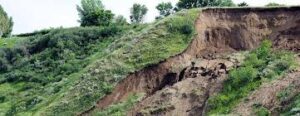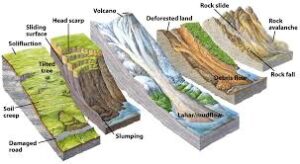Slope Stability: Understanding, Analysis, and Mitigation
Slope stability is a critical aspect of geotechnical engineering and environmental science that concerns the integrity and safety of earth slopes. Whether natural or artificial, slopes are ubiquitous in the landscape, found in hillsides, embankments, and excavations. Understanding the factors that influence slope stability, the methodologies for assessing it, and the strategies for mitigating slope failures is essential for safeguarding infrastructure, protecting the environment, and ensuring public safety. This essay delves into the concepts of slope stability, the various factors influencing it, analytical and empirical methods for stability assessment, case studies of slope failures, and effective mitigation strategies.
Understanding Slope Stability
Definition of Slope Stability
Slope stability refers to the ability of a slope to resist failure due to gravitational forces, external loads, and environmental conditions. A slope is considered stable when it can withstand these forces without undergoing significant deformation or failure. Conversely, slope failure occurs when the forces acting on the slope exceed its resisting forces, resulting in landslides, rockfalls, or other forms of mass movement.
Types of Slope Failures
Slope failures can be classified into several categories based on the nature of the movement and the materials involved:
- Rotational Slides:Characterized by the rotational movement of a mass of soil or rock along a curved failure surface, often occurring in clayey soils.
- Translational Slides:Involve the sliding of material along a planar surface, typically occurring in cohesive or granular soils.
- Debris Flows:Rapid flows of loose, saturated materials down a slope, often triggered by heavy rainfall or rapid snowmelt.
- Rockfalls:The sudden detachment of rock masses from a slope, usually occurring in steep, rocky terrains.
- Topple Failures:Occur when a mass of rock or soil rotates forward and falls, typically seen in steep cliffs or rock formations.
Factors Influencing Slope Stability
Several factors contribute to the stability of slopes, and understanding these factors is crucial for effective assessment and mitigation.
- Geological Factors
- Soil Type:Different soil types exhibit varying shear strengths. Cohesive soils (like clays) generally have higher shear strength than granular soils (like sands) but can be more susceptible to changes in water content.
- Rock Structure:The orientation of rock layers, joints, and faults can significantly influence slope stability. Weak planes, such as bedding planes or fractures, may serve as failure surfaces.
- Geological History:The past geological events, including erosion, volcanic activity, or seismic events, can affect slope stability by altering the landscape and material properties.
- Hydrological Factors
- Water Content:The presence of water significantly affects the shear strength of soil. Increased water content can lead to pore pressure buildup, reducing effective stress and stability.
- Drainage Conditions:Poor drainage can lead to water accumulation, resulting in saturation and increased risk of failure. Conversely, effective drainage can enhance stability.
- Rainfall and Snowmelt:Intense rainfall or rapid snowmelt can trigger slope failures by increasing water content and reducing shear strength.
- Topographical Factors
- Slope Angle:Steeper slopes are generally more prone to failure due to the increased gravitational forces acting on them.
- Slope Height:Higher slopes may experience greater forces due to their height, leading to increased risk of failure.
- Aspect:The orientation of the slope can influence temperature and moisture conditions, affecting vegetation cover and erosion rates.
- Human Activity

- Excavation and Construction:Activities such as cutting into slopes for road construction or building foundations can destabilize existing slopes.
- Loading:Adding weight to a slope, such as through buildings or heavy vehicles, can increase the likelihood of failure.
- Vegetation Removal:Clearing vegetation can reduce root strength, which helps stabilize slopes, and can increase erosion.
Analytical and Empirical Methods for Stability Assessment
Assessing slope stability involves various analytical and empirical methods that provide insights into the factors affecting stability.
- Limit Equilibrium Methods
Limit equilibrium methods are widely used for slope stability analysis. These methods assess the balance between driving and resisting forces along a potential failure surface.
- Method of Slices:This approach divides the slope into slices, calculating the forces acting on each slice to determine the overall stability of the slope. Common variants include the Bishop’s method and Janbu’s method.
- Factor of Safety (FS):The factor of safety is a critical parameter in slope stability analysis. It is defined as the ratio of resisting forces to driving forces. An FS greater than 1 indicates stability, while an FS less than 1 indicates failure.
- Finite Element Analysis (FEA)
Finite element analysis is a numerical method that allows for a more comprehensive assessment of slope stability by considering the spatial variability of material properties and complex geometries.
- Modeling Complex Geometries:FEA can model irregular shapes and heterogeneous materials, providing a more accurate representation of real-world conditions.
- Stress Distribution Analysis:FEA enables the analysis of stress distribution within the slope, helping to identify potential failure zones.
- Empirical Methods
Empirical methods rely on field data and observations to assess slope stability. These methods can include:
- Slope Stability Charts:Graphical representations that correlate various parameters (such as slope angle and soil properties) with stability, allowing for quick assessments.
- Field Observations:Monitoring signs of instability, such as cracks, tilting trees, or soil movement, can provide valuable insights into slope behavior.
Case Studies of Slope Failures
Examining historical slope failures can provide insights into the causes and consequences of such events. Here are notable examples:
- The Vaiont Dam Disaster (1963)
The Vaiont Dam disaster in Italy is one of the most catastrophic landslides in history. In October 1963, a massive landslide into the reservoir behind the dam caused a wave that overtopped the dam, resulting in the deaths of nearly 2,000 people.
Causes:
- Geological factors included the instability of the rock mass above the dam, which was exacerbated by heavy rainfall and previous geological surveys that underestimated the risk.
- Poor drainage conditions and a lack of adequate monitoring contributed to the disaster.
Lessons Learned:
- The importance of thorough geological assessments and continuous monitoring of slopes in dam construction.
- Recognizing the impact of water levels on slope stability.
- The Aberfan Disaster (1966)
In Aberfan, Wales, a coal tip collapsed onto a school and houses, killing 144 people, including 116 children. This tragic event was attributed to heavy rainfall saturating the coal waste and destabilizing the slope.
Causes:
- The design and location of the coal tip, combined with poor drainage, led to instability.
- The absence of proper regulations regarding waste disposal in steep terrain contributed to the disaster.
Lessons Learned:
- The need for stringent regulations and monitoring of waste disposal sites.
- Understanding the potential impacts of weather on slope stability.
- The Oso Landslide (2014)
The Oso landslide in Washington State, USA, was a significant event that claimed 43 lives. The landslide was triggered by prolonged rainfall that saturated the soil.
Causes:
- The geology of the area, including unstable glacial deposits, played a crucial role.
- Human activities, such as land use changes and deforestation, contributed to the destabilization.
Lessons Learned:
- The importance of land-use planning and monitoring of areas with known geological instability.
- The need for community preparedness and early warning systems for landslide-prone areas.
Mitigation Strategies for Slope Stability
Mitigating slope instability involves various strategies that can enhance the resilience of slopes against failure. These strategies can be categorized into preventive measures, active measures, and passive measures.
- Preventive Measures
Preventive measures aim to minimize the factors contributing to slope instability:
- Site Selection:Avoiding construction on steep slopes or unstable geological formations can prevent potential failures.
- Vegetation Management:Maintaining vegetation on slopes can enhance stability through root reinforcement and erosion control.
- Drainage Control:Implementing proper drainage systems, such as ditches and drains, can reduce water accumulation and pressure within slopes.
- Active Measures
Active measures involve direct interventions to stabilize slopes:
- Retaining Structures:Building retaining walls, soil nails, or gabions can help prevent soil movement and provide lateral support.
- Soil Stabilization Techniques:Methods such as grouting, chemical stabilization, and soil compaction can enhance soil strength and reduce the likelihood of failure.
- Slope Reshaping:Reducing the angle of a slope can decrease the driving forces acting on it, thus enhancing stability.
- Passive Measures
Passive measures are designed to enhance the natural stability of slopes:
- Monitoring Systems:Implementing monitoring systems to detect early signs of instability (e.g., inclinometers, piezometers) can provide crucial information for timely intervention.
- Early Warning Systems:Developing community-based early warning systems for landslides can help reduce risks by alerting residents to potential dangers.
- Education and Awareness:Raising awareness about slope stability issues and promoting responsible land use practices can contribute to long-term stability.
Conclusion
Slope stability is a complex and multifaceted issue that encompasses various geological, hydrological, and anthropogenic factors. Understanding these factors and employing effective assessment techniques are crucial for predicting and mitigating slope failures. Through the examination of historical case studies, we can learn valuable lessons that inform our approaches to slope stability.
By implementing a combination of preventive, active, and passive measures, we can enhance the resilience of slopes and safeguard lives, property, and the environment. As climate change continues to alter weather patterns and increase the frequency of extreme weather events, the importance

